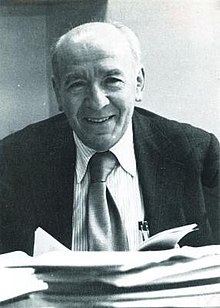Mark Kac
Mark Kac (also Marek Kac ; born August 3, 1914 in Kremenez , † October 26, 1984 in California ), pronounced [ ˈkaʦ ], was a Polish - American mathematician .
Life
Kac was born to Jewish parents in the General Government of Warsaw , part of the Russian Empire . In 1915 the family was evacuated to Russia, and he received home tuition from his father, learned French from his governess , but only learned Polish after returning to Poland in 1921. There he studied at the University of Lemberg in Lemberg under Hugo Steinhaus , with whom he also became friends was, mathematics and received his doctorate in 1937. He applied for a scholarship to the USA and finally came in 1939 to Cornell University in Ithaca , New Yorkwhere he became a professor in 1947. In 1961 he went to Rockefeller University in New York City and in 1981 to the University of Southern California .
His main area of work was probability theory , especially its application in statistical mechanics. With Richard Feynman he gave a path integral solution of the Fokker-Planck equation (it describes the development of a probability distribution over time under drift and diffusion , for example in the case of Brownian motion ), the Feynman-Kac formula , which, for example, with the Monte Carlo method can be approximated. He was with Paul Erdős , with whom he worked several times, a pioneer in the application of probability theory in number theory , where George Pólya had already given a probabilistic interpretation of the prime number theorem . Kac and Erdős give such a "derivation" in the American Journal of Mathematics Vol. 62, 1940, p. 738. They proved exactly that the number of prime factors of a number is normally distributed ( Erdős-Kac's theorem ). Furthermore, Kac worked on the theory of phase transitions and on exact models in statistical mechanics (spherical model by Kac / Berlin, Physical Review 1952 and others). With John Clive Ward he developed a combinatorial treatment of the two-dimensional Ising model in 1952 .
His essay Can one hear the shape of a drum? , American Mathematical Monthly 1966, which received the American Mathematical Society's 1968 Chauvenet Prize for outstanding mathematical exposures. It is about using the spectrum ( eigenvalues ) of the Laplace operator (which also has connections to probability; the steady-state heat conduction equation is the Laplace equation ) in an area about its geometric shape. Hermann Weyl had already established in 1915 that the asymptotic spectrum of the eigenvalues is determined by the volume of the area. In general, however, the answer is negative (counterexamples provide so-called isospectal areas, i.e. different shapes, identical spectrum). The area gained in importance after the Atiyah-Singer index theorem showed connections between the topology of a manifold and the spectrum of the Laplace or Dirac operator (the "square root" of the Laplace operator) on this manifold and in the 1970s Years of evidence of this theorem has been found using the diffusion equation.
In 1959 he was elected to the American Academy of Arts and Sciences , in 1965 to the National Academy of Sciences and in 1969 to the American Philosophical Society . In 1978 he received the George David Birkhoff Prize for Applied Mathematics.
His PhD students included Harry Kesten and Murray Rosenblatt .
Kac's parents and younger brother perished in the Kremenez ghetto.
Works
- with Stanislaw Ulam : Mathematics and Logic: Retrospect and Prospects. Praeger, New York 1968, Dover paperback reprint.
- Enigmas of Chance: An Autobiography. Harper and Row, New York, 1985. Sloan Foundation Series. Published posthumously with an afterword by Gian-Carlo Rota .
- Statistical independence in probability, analysis and number theory. (Carus Mathematical Monographs No. 12), MAA and John Wiley, 1959.
- Probability, number theory and statistical physics. (Reprint of Kac's work with his commentary and autobiographical note), 1979.
- Probability and related topics in the physical sciences. 1959 (with contribution from Uhlenbeck to the Boltzmann equation and Hibbs to quantum mechanics, Boulder Seminar 1957).
- Random walk and the theory of Brownian motion. American Mathematical Monthly, 1947, p. 369 (also received the Chauvenet Prize).
- On applying mathematics - reflections and examples. Quarterly Journal of Applied Mathematics, Vol. 30, 1972, p. 17.
- with Ward: A combinatorial solution of the 2 dimensional Ising model. Physical Review Vol. 88, 1952, 1332.
- Can one hear the shape of a drum? , American Mathematical Monthly, Vol. 73, 1966, pp. 1-23
literature
- Carolyn Gordon : When you can't hear the shape of a manifold. Mathematical Intelligencer 1989, No. 3.
- Gordon, Webb, Scott Wolpert: One cannot hear the shape of a drum. Bull. American Mathematical Society, 1992, also Science Vol. 255, 1992, 1642.
Web links
- Literature by and about Mark Kac in the catalog of the German National Library
- John J. O'Connor, Edmund F. Robertson : Mark Kac. In: MacTutor History of Mathematics archive .
Individual evidence
- ↑ Mark Kac in the Mathematics Genealogy Project (English)
- ^ Member History: Mark Kac. American Philosophical Society, accessed October 16, 2018 .
| personal data | |
|---|---|
| SURNAME | Kac, Mark |
| ALTERNATIVE NAMES | Kac, Marek |
| BRIEF DESCRIPTION | Polish mathematician |
| DATE OF BIRTH | August 3, 1914 |
| PLACE OF BIRTH | Kremenets |
| DATE OF DEATH | October 26, 1984 |
| Place of death | California |
